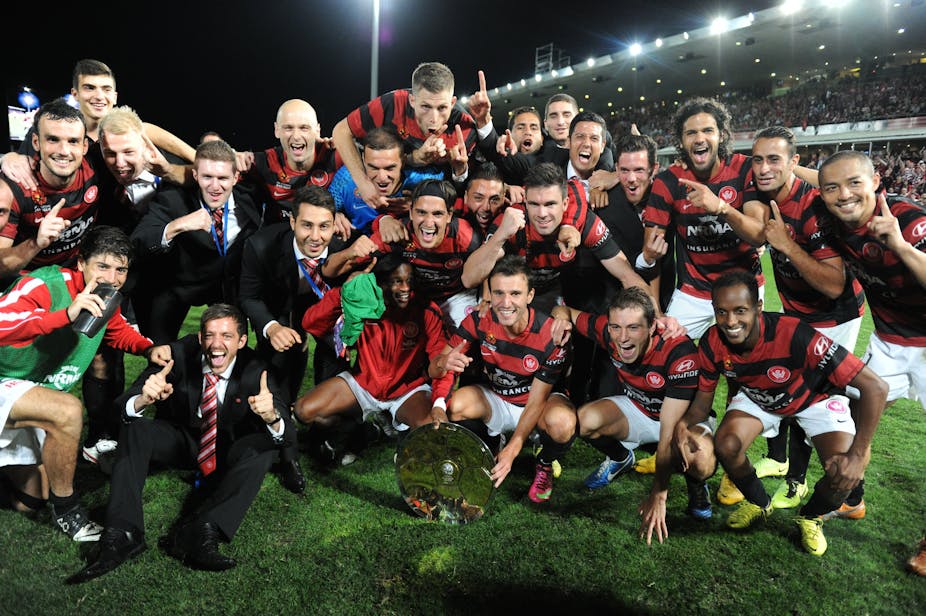Western Sydney Wanderers’ inaugural A-League season is the feel-good sports story of the year. The team is undefeated in 13 matches, won the league (generally regarded as the “real” championship in soccer in almost every other country), and will this evening play off in the Grand Final.
Their brilliantly loud and colourful supporters turn out in impressive numbers at home and away matches, and they play a reasonably attractive style of soccer centred on their sublime Japanese midfielder Shinji Ono.
Doping allegations surrounding other codes and the usual assortment of indiscretions by NRL players have contributed to the growing media fascination with the Wanderers. Their on-field achievements, however, are remarkable in their own right, especially for a club whose existence was announced by Football Federation Australia in April 2012.
Sports journalists have been falling over themselves in praising the Wanderers. Fairfax soccer writer Michael Lynch’s article in the Sydney Morning Herald last week included a familiar reference to the Wanderers “fairytale” season, and concluded that:
Irrespective of the outcome next weekend, the Wanderers must surely go down in history as one of the most extraordinary success stories in Australian sport.
But fairytales, of course, often have a decidedly dark side. Logic and history dictate that a first year club in a professional sports league should struggle against established opposition on the pitch. The near-weekly thrashings handed out to the fledgling Greater Western Sydney AFL club should be the norm.
The ability of a team in any code to dominate an established league in its first season of existence says far more about the league itself.
Questionable decisions made by league officials in handing out the first batch of licences and the subsequent financial bailouts of a number of clubs; an ad hoc expansion policy that saw clubs come and go on the Gold Coast and Townsville in short order; and the often dire standard of refereeing which has blighted past finals are examples of how badly the league has been run.
The salary cap, however well-meaning, has become a real obstacle to keeping the sort of decent standard of Australian players that the league depends on. Star Australian players like Mark Schwarzer and Tim Cahill will always migrate to the big European leagues, but even lower level clubs (particular in the UK) and the burgeoning and better-financed leagues in Japan, Korea, China are all competing for players.
At the other end of the scale, the petro-dollar Qatari and UAE retirement leagues make them an increasingly attractive option for Australians who might otherwise commit to the A-League near the end of their careers. If the OzFootball website is an accurate indication, there are some 175 Australians playing in leagues across the globe.
A-League instability, however, creates a level playing field and doesn’t account for the Wanderers dominance. Some have pointed, often critically, to the league’s concession that allows the Wanderers to have seven overseas players on their books, two more than the allowance for other clubs, in its first two years of operation. In effect, according to A-League boss Damien de Bohun, the policy reflects the very limited talent pool Western Sydney had to work with when trying to form a squad last year
If having a couple of extra imports and the managerial nous of A-League Coach of the Year Tony Popovic have contributed to the Wanderers success, the reality of their meteoric rise is that many of the long-standing clubs in the league have achieved little in terms of creating a stable organisation with a reliable youth system and scouting network.

Their opponents in today’s decider, the Central Coast Mariners, as well as Melbourne Victory (despite the ludicrous name) and - in recent years at least - Brisbane Roar are the only exceptions. Central Coast, given their perennial financial limitations, have been particularly impressive in building a successful organisation based largely on developing its own players.
The most obvious comparison with the Wanderers is Sydney FC, an A-League foundation club and champions in the first A-League season. They won the championship again in 2009/10, but for the most part, the organisation has been a basket case that has seen changes in ownership, seven chief executives, eight managers, and a conveyor belt of players that has been punctuated by reliance on often underachieving marquee signings. One effect of such mismanagement has been generally poor attendances that were finally improved by last season’s signing of legendary Italian player Alessandro Del Piero.
Sydney FC may be the most explicit example of how not to run a soccer club, but things aren’t enormously different - or better - in Newcastle, Adelaide, Perth, Wellington or with Melbourne’s second team, the Heart.
Ironically, given its less than impressive overall record, the FFA administrators who run Western Sydney seem to have got this one right. But to a considerable extent, much of the Wanderers’ success was gifted to them by the ineptitude of many of the other teams in the league.

